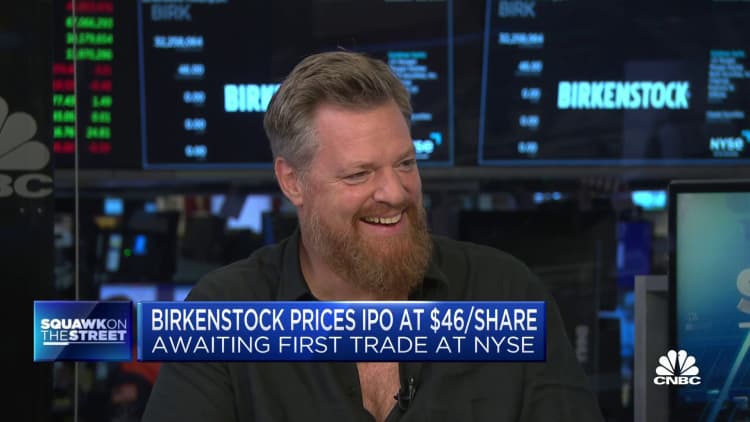
A Birkenstock banner hangs outside the New York Stock Exchange (NYSE) in New York on October 11, 2023, as Birkenstock launches an Initial Public Offering (IPO).
Angela Weiss | Afp | Getty Images
Shares of Birkenstock slid about 10% in their debut on the New York Stock Exchange on Wednesday, after the longtime German shoe brand started trading at $41 per share.
Birkenstock’s opening share price came in about 11% lower than its initial price of $46 set Tuesday, which was just shy of the midpoint of its expected range of $44 to $49 per share. Birkenstock sold 10.75 million ordinary shares in the offering, raising about $495 million and valuing the company at about $8.64 billion.
Birkenstock had originally sought a valuation of up to $9.2 billion.
The company’s market debut comes nearly 250 years after it was founded by German cobbler Johann Adam Birkenstock. It remained under family control until 2021 when private equity powerhouse L Catterton acquired a majority stake in a deal that valued the business at $4.85 billion.
In an interview on CNBC’s “Squawk on the Street,” Birkenstock CEO Oliver Reichert explained why the company decided to go public.
“The best thing for the brand would be staying family owned, but within the family there were so many problems, so we go for the second best option and that’s to be public and give the brand back to the people,” said Reichert.

Since L Catterton acquired its stake, sales have grown and Birkenstock’s valuation has nearly doubled. Between fiscal 2020 and 2022, sales jumped from 728 million euros ($771 million) to 1.24 billion euros. Over that time, the company grew direct-to-consumer sales, strategically exited certain wholesale partnerships and focused on driving sales of items with higher price points.
It posted net income of about 187 million euros in fiscal 2022 and saw margins of about 60%. Birkenstock has room to grow those margins if it expands its direct-to-consumer sales, which have grown from 18% of sales in fiscal 2018 to 38% in fiscal 2022, it said in a securities filing.
The offering comes as the IPO market gradually begins to defrost after more than a year of stagnation. But it has remained choppy and uncertain. Multiple recent IPO filers did well in their first couple of days of trading, but those stocks have since fallen.
Instacart priced its long-awaited IPO at $30 per share last month. But after an initial 40% pop, it closed at $33.70 on its first day on the Nasdaq and is now trading below its opening share price. Oddity Tech, another L Catterton-backed consumer company, debuted on the public markets in July with a 35% pop and saw its stock close at $47.53 after the first day of trading. Soon after, it reached a high of $56 per share but since then, Oddity’s stock has fallen and is now trading below its initial offering price of $35.
A similar trend has followed Johnson & Johnson spinoff Kenvue.
The footwear and apparel sectors have been under pressure this year as consumers shift their spending from goods to services. But Birkenstock’s growth, sustained profitability and cultural relevance after its recent cameo in the “Barbie” movie have sparked interest from investors.
“Birkenstock is a long-standing brand but it fits into the trend of embracing casual comfort in the workplace after COVID. It continues to grow even in the face of a declining global footwear market, as consumers allocate their disposable income to other interests, such as travel,” Alex Smith, global sector lead at research firm Third Bridge, said in an emailed note.
“The current growth is being driven by a younger, new consumer base and its rising popularity among celebrities – even Barbie has been spotted wearing Arizona sandals.”
Despite its long history, Smith noted Birkenstock still has room to grow. Its customer base is still primarily female customers because of its sizing options and manufacturing capabilities, and it could expand sales outside of the U.S. and Europe.